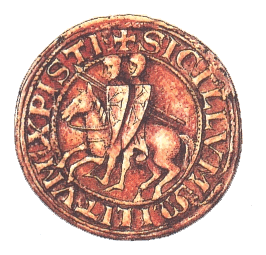
The great seal of Pauperes commilitones Christi templique Salomonis
the Poor Fellow-Soldiers of Christ and the Temple of Solomon or Knights Templar

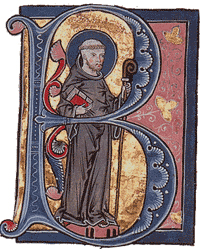 |
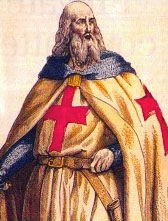 |
 |
 |
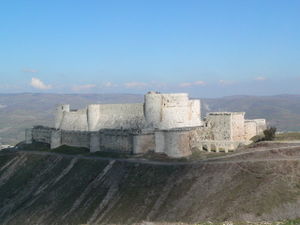 |
WHO WERE THE TEMPLARS?by Terence Wilson |
The Knights Templar were a religious military order founded in Jerusalem in AD1119 to protect pilgrims travelling to the Holy Land. During the 12th and 13th centuries the Templars played an important role in the crusades sanctioned by Pope Innocent II who in AD1139 placed the Templars under direct papal authority.
Initially begun as a group of French knights led by Hugues de Payens this holy brotherhood, or to give them their full designation, 'The Order of Poor Fellow-Soldiers of Christ and of the Temple of Solomon' (Pauperes commilitones Christi templique Salomonis) referring to their original headquarters on the site of the Temple of Solomon which was given to them by King Baldwin II of Jerusalem, lived under austere vows of poverty and chastity according to the rule of St Bernard of Clairvaux. The order comprised four ranks: servants, chaplains, sergeants, and knights, the latter wearing white surcoats with the red cross of St. George. In the 13th century there were as many as 20,000 knights.
Over the years the order acquired great wealth derived from pious gifts from European kings and nobles. Feudalism and the ownership of land and estates throughout France, Spain and England also furnished them with many assets. Later they supplemented their wealth with financial activities. Their international links allowed them to adapt to the 13th-century decline of the Crusader states by becoming Europe’s bankers. The Templars’ independence, power and wealth, rather than their alleged heresy, motivated Philip IV of France, helped by the Avignon Pope Clement V, to suppress the order between AD1307 and AD1314.
On Friday October 13th 1307, hundreds of Knights Templar were arrested in France and under torture admitted to a series of crimes against church and state. Philip IV was behind this ruthless move, but the Pope was also involved. From the day of Clement V’s coronation in June 1305, the king falsely charged the Templars with heresy, immorality, and abuses, Among the many blasphemies to which they admitted were sodomy, worshipping an idol – an embalmed head of the demon Bapomet or Baphomet – and of re-writing the Bible. On March 18th 1314 by the order of King Philip IV, the Grand Masters Jacques de Molay and Geoffrey de Charnay were burned at the stake in Paris.
After this horrifying bloody suppression, their property throughout Europe and the near east was divided between their great rivals the Knights Hospitallers and various secular rulers. In England, under the rule of king Edward II, lands previously owned by the order were seized and Cressing Temple was handed to the Knights of St. John of Jerusalem near West Smithfield London.
Philip IV of France was born between April–June 1268 and died age 46 on 29th November 1314. He suffered a cerebral ictus during a hunt at Pont-Sainte-Maxence (Forest of Halatte) and died a few weeks later in Fontainebleau, where he was born. He is buried in the Basilica of St Denis. It was rumoured that this was God's revenge for slautering the templars.
CRESSING TEMPLEfrom “The Templars, Knights of God”By Edward Burman |
It is no surprise to learn that the first recorded grant of land to the English Templars occurred in 1137 when Matilda, Queen of England and niece to Baldwin I of Jerusalem, endowed the Order with the Essex manor of Cressing. This land, later the site of an important preceptory, is typical of the early Templar properties: it included an estate at Uphall, and the manor and half- hundred of Witham, and stood on the main road from London to Colchester. It was gradually extended by small gifts of between 1-5 acres until, by the end of the twelfth century, it included land in the villas of Terling, Fainstead, Great Leighe, Naylinghurst, across the river Brain from Temple Cressing, towards Braintree, at Bradwell, Galdingham, Mundon, and Layer de la Hay, with houses at Sudbury and Maldon and the manor of Finchingfield. The whole property comprised about 160 tenants by the end of the century and Lees concludes that:
“The central position of the Temple Cressing preceptory, within comparative easy reach of London, the fertility and diversity of the soil, the excellence of the pasturage, and the convenient roadways and waterways gave it a value out of proportion to its size.”
The usual terminology for the domus or Templar ‘house’ was templum or le tempil, but there were in fact different types of rural economy gathered for convenience under this common usage. The domus, modelled on manorial husbandry, was the basic administrative unit whose main types were:
Many donations to the Order were also small, those to the preceptory at Temple Cressing in Essex being usually of between one and five acres. Tenancies were correspondingly fragmented so that Cressing had a total of 160 tenants.
Matilda daughter of Henry I married Emperor Henry V in 1114. When Henry V died in 1125 Matilda ruled England and two years later the English barons took an oath of allegiance to Matilda as rightful successor to Henry I. In 1129 she married Henry Plantagenet of Anjou. When Henry I died in 1135 the English crown was seized by Stephen of Boulogne. Matilda’s claim to the English throne led to civil war during which her claim was supported by David I of Scotland whose troops were defeated at the Battle of Northallerton.
(In 1141 at the Battle of Lincoln, Stephen was defeated and captured. Matilda became ‘Lady of England’. The following year Stephen was exchanged for Robert of Gloucester re-newing the civil war and Matilda was beseiged at Oxford. Later, in 1147 she left England and four years later, following the death of Geoffrey Plantagenet he was succeeded by her son Henry. Two years later, in 1154, Stephen died and Henry became Henry II, the first Plantagenet king of England.
(This gift of land to the Knights Templar may have been influenced by the need to secure the support of the Order in Matilda’s fight against Stephen for the English crown. Ed.)
KNIGHT TEMPLARS HOUSEA 16th Century house, Kelvedon. Essexby Terence Wilson |
In 1971 Pamela and I moved to Kelvedon, Essex where we purchased an old brick-faced terraced house at No. 5 The High Street. Over 400 years old, over the front door of the house was a carved plaque “Knight Templars Terrace 1861”. Inside, the fabric of the house needed substantial renovation and much of our spare time was spent renovating generations of neglect. We were assured that because the house dated from c1490, the name over the door was the only link with the Templars.
While working in the large bedroom over the living-room I removed a layer of thin rotten boards nailed to a substantial oak sub-floor. It transpired that this sub-floor was actually nailed onto the oak ceiling of the room below comprised of huge carved beams roughly 23cm apart branching out from an even larger carved beam running down the centre of the room. While cleaning these timbers I discovered what appeared to be a fossilised dead rat encased in hard clay secreted in a large crack in one beam. On closer examination I could make out writing. The ‘rat’ turned out to be a tightly screwed-up piece of parchment which added further to the mystery of the house and the relevance of its link with the Knights Templar.
Extremely carefully the parchment was steamed open revealing a page from a book 160mm x 230mm. Each side of the sheet was beautifully hand-written in 12th century Latin script:
| Pug..... frib; urif Fr venit irib°
orclunb° Et ut cognouert qa machal..... .....ifecnta eft eof indaf ceciderex eif illa die octe milia.... Et indit eleazar filio saura una de bestus lorica......loricis rigis. ....erat ....neus sup cetas bestias. Et infu ...ei quod inca eaet xxx: & deci seuchbarer ....suii adqirer s nom etnui. Et cucururie ad ea indacr imedi....uficiens aderis i asmistrus |
Although I couldn’t understand a word of Latin, at art college I studied calligraphy so painstakingly and assiduously I copied the manuscript from both sides of the parchment onto two sheets of paper. The Latin was almost un-readable with many abbreviations and large holes where the vellum was badly eaten-away by woodworm and death-watch beetles. Nevertheless, certain key words were clear and legible: elephanti and the names regnante demitrio (King Demetrius), elieazor, bethzacharam, capharsalama and timothe (all spelt without capital initials). But who did I know who could read Latin? Then it dawned on me! A Roman Catholic priest. I took my discovery over the road to Canon Dobson, the elderly parish priest at the Church of St Mary the Virgin next-door to the Dominican Convent in Church Lane.
A few days later he returned looking extremely satisfied with his results. ‘It’s a transcription from the First Book of Macabees, Chapters 7 & 8, and the Second Book of Macabees, Chapter 1. This is published in the Apocrypha’, he explained, ‘It’s a report of the Battle of Bethzacharam and the logistics of the armies on both sides: the number of foot-soldiers, cavalry, elephants, etc. engaged in the conflict.’
Now, who would want a copy of such detailed information on military combat? Crusaders fighting in the Holy Land? A military order? One of the many heresies of which the Templars were accused during their persecution in the 14th century was that they ‘re-wrote the Bible’ as mentioned in Edith Simon’s reference work on the Knights Templar.
‘The books were called in and many of them burned. Among those which escaped this fate was ... a volume of extracts from the Bible translated into French. (It comprised abridged versions of Genesis, Joshua, Kings, Maccabees, Tobias, Judith and Judges) ... the Templar Bible consisted mainly of tales of war, and that it’s very existence was illegal, an act of defiance.’
Presenting my discovery to The Bramston Archæological Unit in Witham, who at the time were researching the Templars and Cressing Temple, I was met with a brief letter in reply and polite indifference. However, some years later, I discovered that during the 17th century two workmen from Witham were punished for stealing books from Cressing Temple barns. Could this page have been torn from one of these books? Did some illiterate workman employed on Knight Templars House at the time gathering clay, find one of the discarded books in a nearby field and tore out a page to bind the wet clay to fill cracks in the cross-beam? After we sold the house, in November 1983, the new owners received a letter from the British Museum confirming our discovery.
‘This fragment was examined, in August 1982, by the Supervisor of Western Manuscripts at the British Museum Library and was dated as a 13th century hand of exceptional skill as no single correction or erasure could be detected. It is written on extremely high-quality parchment far thinner than any available these days!The page is almost certainly from a ‘service book’ of those days arranged for daily readings as indicated by the red marginal notations showing a Friday morning & evening and a Saturday morning. The text is taken from The Apocrypha I Maccabees Chapter V verses 31-68, Chapter VI verses 18-46 and Chapter VII verses 27-68. It describes the battles in Jordan between Judas Maccabaeus, King Eupator and the Roman, Demetrius.’
Try as I might, finding a link between these 12th century warrior-monks and the Tudor house in Kelvedon proved unreconcilable. To begin with the dates of the house and this holy order were anachronistic. The Order of the Poor Knights of Christ and the Temple of Solomon was founded in France by Hugh de Payens in 1119. Bound by a solemn vow to live a life of poverty, chastity, obedience and self-denial, the holy knights swore to protect pilgrims and roads in the Holy Land. But that was not their sole objective while in the Holy Land:
‘By 1127, the Templar’s search was over. They had retrieved not only the Ark and its contents, but an untold wealth of gold bullion and hidden treasure....[furthermore] they were granted vast territories and substantial property across the map from Britain to Palestine.’
In 1139 Pope Innocent granted the Templars independence recognising no temporal or religious authority save The Pope. Feudalism and the ownership of land and estates throughout France, Spain and England furnished them with money. One of those benefices was the hundred of Witham with its parishes of Cressing, Rivenhall and Kelvedon. The order was active for almost 200 years, made a considerable fortune and many political and religious enemies.
‘By 1306 the order was so powerful that Philippe IV of France viewed them with trepidation; he owed a great deal of money to the Knights but was practically bankrupt....With papal support [Clement V 1305- 1314], King Philippe persecuted the Templars in France and endeavoured to eliminate the Order other countries.’
On March 18th 1314 by the order of King Philippe IV, Grand Masters Jacques de Molay and Geoffrey de Charnay were burned at the stake in Paris. In England, under the rule of Edward II, lands previously owned by the order were seized:
‘When this order [Knights Templar] was suppressed in 1311, Cressing Temple with their possessions passed to of St. John of Jerusalem, near West Smithfield [London]:’
Among the many blasphemies which the Templars admitted under torture was worshipping an idol - an embalmed head of the demon Bapomet - and re-writing the Bible.
‘In spite of the surprise effect of the arrests in 1307 and in spite of exhaustive research, the idol which thousands of prisoners confessed to having worship(p)ed - the the head of wood, of silver, bearded, beardless, eyeless, carbuncle-eyed, life-sized, larger than life, the size of a fist - no such idol was unearthed.’
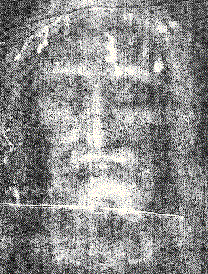
It is believed that this ‘idol’ could have been the enigmatic Shroud of Turin showing a negative image of the face of Jesus. The Shroud made its sudden appearance in the tiny village of Lirey, France on September 19th, 1357 by his widow following the death of Geoffrey de Charney, standard bearer to King John II of France at the Battle of Poitiers. The description of a head, bearded, with large carbuncle-like eyes is quite an accurate description of the face on The Shroud. Wrapped, only the face on The Shroud is exposed and if unwrapped it is indeed ‘life-sized’. In 1978 tests using carbon dating proved beyond doubt that The Shroud of Turin is a 12th century fake. Nevertheless the Templars believed it was the face of Christ. In a church at Templecombe, near Yeovil in Dorset, there is a painted panel matching the image on The Shroud but with large, open ‘carbuncle’ eyes.
Two centuries later, in 1538, came the Dissolution of the Monasteries in the reign of Henry VIII when monasteries, abbeys and land belonging to various holy orders were seized and lands historically owned by the Templars and now owned by the Knights of St John were confiscated a second time. But Henry’s Catholic daughter Mary’s sympathies lay with the Old Religion and she restored these lands once again for a period of five years between 1553 and 1558:
‘Queen Mary I re-founded the house of the knights hospitallers ... and granted them the manors of Witham, Purfleet, Temple-Roding and Chingford; these at her death, again reverted to the Crown ...Cressing formed part of the possessions of Earl Harold, and succeeding proprietors of Witham, til the time of King Stephen, who about the year 1151 granted this manor, with the avowson of the church, to the knights templars, and it hence received the name of Cressing Temple, and was made a preceptory or commandery ... (a capital messuage with lands belonging to this society and headed by a commander. Preceptories were benefices possessed by the most eminent Templars created by the chief master and named Præceptores Templii. Of these there were sixteen in England of which Cressing was the first in importance.)
Following the general suppression of religious houses, particularly of the knights hospitallers in 1540, the Manor of Cressing, and half-hundred of Witham granted, in 1541 to Sir William Huse, from whom they passed to the Smyth family, who long flourished at Cressing Temple. Their ancestor was Sir Michael Carrington, standard-bearer to King Richard the First, in his expedition to the Holy Land.’
We know from manor court records and Thomas Wright’s book that during the 16th century Church Hall Manor included all the land and property in the village of Kelvedon and belonged to the bishop of London:
‘Church Hall is so named from its vicinity to the church [of St Mary the Virgin]. It was holden under Edward the Confessor, by Angelic, one of his nobles, who gave it to Westminster Abbey ... It remained part of the endowment of Westminster Abbey til its suppression ... it was given, by King Edward the Sixth, to the Bishop of London ... together with the rectory and avowson.’
So there is no direct historical connection between the house we called our home and the Knights Templar save for a Victorian flight of fancy in the name. Or as Andrew Hamilton puts it, ‘These residences are styled Knights Templars’ Terrace from a tradition that this inn was once in the possession of that fraternity.’ All the same, I had discovered a page from a Templar Bible in Knights Templars House. The only clue as to the original builders and owners of the house was the coat-of-arms uncovered by Andrew Hamilton around 1860:
‘Only one token as to date beyond the undoubted style and general character of the whole carving existed, and that exception was the supporters to a shield bearing a heart pierced with two crossed darts. These supporters were the Lion and Griffon of Henry VIII.’
Basil Kentish, in ‘Kelvedon and its Antiquities’, refering to Marler’s House just across Church Lane from Knight Templars House, mentions:
‘The house eventually became the home of six "old Templars" until it was bought by the Rev. James Salisbury Dunn who took in several boys to prepare them for college.’
Today Knight Templars House, Kelvedon is a Grade I Listed building.
(This article was later published in "The Temple" and is now one of a collection of articles available in "The Templar Papers" compiled and edited by Oddvar Olsen published by New Page Books.)
Knights Templar, The Templar PapersTHE TEMPLE OF SOLOMON |
As previously mentioned, (see "Who Were the Templars?") when Hugues de Payens and his knights arrived in the Holy Land, King Baldwin II of Jerusalem granted them quarters on Temple Mount. This was the site of King Soloman’s Temple from where the Templars get their name, 'Pauperes commilitones Christi templique Salomonis' (the Poor Fellow-Soldiers of Christ and the Temple of Solomon). Originally these ruins were the stables beneath the the Temple until it was destroyed by the Babylonians in BC586. According to Jewish tradition, the Temple contained, among other things, the Ark of the Covenant.
TEUTONIC KNIGHTS & GRAIL LORE |
Later, the Templars also discovered the site of the Temple of Sion (Zion) location of the ‘upper room’ where Jesus and the apostles celebrated ‘The Last Supper’ or ‘Feast of the Passover’ before Christ was crucified and when the grail was passed around:
27. And he took the cup, and gave thanks, and gave it to them, saying, Drink ye all of it;In 1547 the Roman Church condemned Grail Lore as a heresy even though tradition perceived the Holy Grail as a Christian relic.
28. for this is my blood of the new testament, which is shed for many for the remission of sins.
(The Bible. The Gospel according to St. Matthew Chap. 26)
In Wagner's opera 'Parsifal' the primary purpose of the drama is to convey to the audience the importance of compassion; the only valid basis for morality, according to Schopenhauer. This teaching was accepted by his disciple Richard Wagner. It is through compassion for the suffering of other beings that the fool acquires wisdom and becomes a sage. It is through the perfection of wisdom that he is able to bring salvation.
ROSICRUCIANS, FREEMASONS & ST JOHN'S AMBULANCE |
In his book, "Bloodline of the Holy Grail" Laurence Gardner points out that,
“…the Rosicrucians (like the Cathars and Templars before them had access to an ancient knowledge which held more substance than anything promulagated by Rome.”

Listed among the adherents to the Rosicrucian beliefs was Dante, Columbus, Francis Bacon, Christopher Wren, and Robert Fludd who assisted in translating the King James (Authorised) Bible. During the 16th century the Rosicrucians were connected with Freemasonary and in the present day the St John's Ambulance Service (descendants of the Knights Hospitallers of Saint John of Jerusalem) is a familiar feature at every public event.
During the 16th century the Rosicrucians were connected with Freemasonary and in the present day the St John's Ambulance Service (descendants of the Knights Hospitallers of Saint John of Jerusalem) is a familiar feature at every public occasion. Many freemasons maintain Enochian and Noachide customs. When the Enochian-Zadokite priests were expelled from Jerusalem by the Romans in AD70, having first hidden their scrolls and treasures deep under the ruins of Solomon's Temple (as recorded in the Qumran Copper Scroll, it seems possible that the Knights Templar might discover them.
THE SOVEREIGN MILITARY ORDER
The Templar Order Today
|
Envied, victimised and feared for their wealth, knowledge and power, and despite the suppression of the order, the legacy of the Knights Templar lives on. During the 16th century during the 'Age of Reason', Protestantism emerged under the banner of the Red (or Rosy) Cross granted to the Templars by St. Bernard of Clairvaux during the 13th century.
It is significant that when it was established in Geneva in 1864 the international relief agency is identified by the familiar Red Cross. Today the Knights Templar are a worldwide network. The order may be found at:
 |
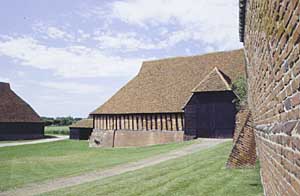 |
 |
|
CRESSING TEMPLE BARNS Are open to the public Easter Sunday to 30th September Mon-Fri 9:30 am to 4:30pm. Sunday 10:30 am to 5:30 pm. Entrance £3.00 adults, £1.50 concessions. Telephone 01376 584453 ============================================ |